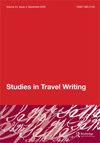Mapping in process: discourse analysis of the Alpine Club’s periodicals
Q2 Arts and Humanities
引用次数: 2
Abstract
ABSTRACT The Alpine Club of London, founded in 1857, was the first Alpine Club in the world. Its periodicals, Peaks, Passes, and Glaciers and The Alpine Journal provide important travel narratives which record the members’ mountain-explorations. This interdisciplinary article aims to show the alpinists’ contributions in two domains. First, by mapping the Alps their geographical accomplishments were considerable. Their additions to existing maps were also the result of their success in changing dead-ends into tracks and routes. Based on the exploration of a digitalised corpus of these periodicals (1858–1899), this article reveals some of the most salient traits of the discourse on their shaping of borders. This approach involves discourse analysis (pragmatics, linguistics of enunciation) as well as history and geography. On top of their existence as potent earthly landmarks and challenges for humans, the mountains have always been geographical objects in motion.绘图过程:阿尔卑斯俱乐部期刊的话语分析
伦敦高山俱乐部成立于1857年,是世界上第一家高山俱乐部。它的期刊《山峰、隘口和冰川》和《高山杂志》提供了重要的旅行叙述,记录了成员们的登山探险。这篇跨学科的文章旨在展示登山运动员在两个领域的贡献。首先,通过绘制阿尔卑斯山的地图,他们在地理上取得了相当大的成就。他们成功地把死胡同变成了轨道和路线,这也是他们在现有地图上添加新内容的结果。基于对这些期刊(1858-1899)的数字化语料库的探索,本文揭示了关于它们塑造边界的话语的一些最显著的特征。这种方法包括语篇分析(语用学、发音语言学)以及历史和地理。除了作为地球上的地标和对人类的挑战之外,山脉一直是运动中的地理物体。
本文章由计算机程序翻译,如有差异,请以英文原文为准。
求助全文
约1分钟内获得全文
求助全文
来源期刊

Studies in Travel Writing
Arts and Humanities-Literature and Literary Theory
CiteScore
0.40
自引率
0.00%
发文量
13
期刊介绍:
Founded in 1997 by Tim Youngs, Studies in Travel Writing is an international, refereed journal dedicated to research on travel texts and to scholarly approaches to them. Unrestricted by period or region of study, the journal allows for specific contexts of travel writing to be established and for the application of a range of scholarly and critical approaches. It welcomes contributions from within, between or across academic disciplines; from senior scholars and from those at the start of their careers. It also publishes original interviews with travel writers, special themed issues, and book reviews.
 求助内容:
求助内容: 应助结果提醒方式:
应助结果提醒方式:


